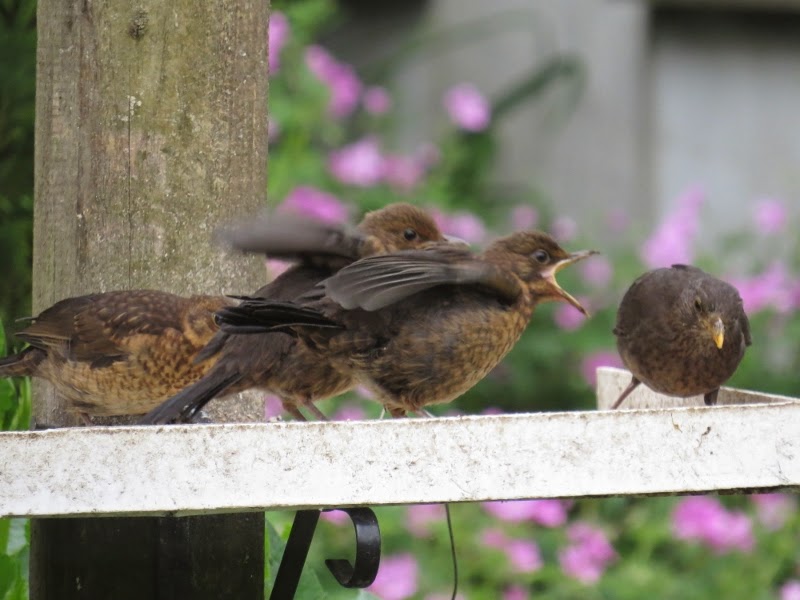June 2014
I think I will start using Latin names for the species which will be an aid to help me learn them and as a way to avoid confusion between species.So far we have not seen many corvids in the garden although there are plenty in the area around us. However they have started to venture more often into the garden now. By 08:40 on the 6th I had seen three jackdaws (Corvus monedula), a rook (Corvus frugilegus)and a jay (Garrulus glandarius). They are very cautious and don't stay long.
This was another month for the sighting of many juvenile birds visiting the feeders usually in the company of at least one parent. Here is a list of some of the sightings;
8th Coal tit (Periparus ater) and great tit (Parus major)
20th Three blackbirds (Turdus merula) on the bird table being fed by the mother. The young could be mistaken for thrushes because they have similar breast patterns.
21st Tree sparrow (Passer montanus) feeding the young with seeds. These were part of a flock of mixed sparrows numbering at least 30. A young starling was seen on the same day being fed with mealworms.
23rd A baby robin (Erithacus rubecula) on the bird table.
We were also treated to the arrival of our first juvenile great spotted woodpeckers (Dendrocopos major). The first sighting was on the 5th. I could see the male parent taking suet to feed a bird on a distant branch. Eventually the juvenile came closer but still kept his distance from the feeders and waited for the parent to bring the food to him. On the 10th a juvenile was feeding alone on the fat balls.
On the 15th the two juveniles were on the feeders together with a female GSW. One was feeding independently. However by the 18th the two juveniles were fighting each other over access to the fat balls.
One of the juveniles had a narrow escape when a sparrowhawk (Accipiter nisus) swooped past the feeders. Another bird did not have such luck and was seen spread spreadeagled on the ground, pinned down by the sparrowhawk, whilst it pecked at. I couldn't see what type of bird it was but it seemed to have wide narrow wings like a swift or swallow. After about five minutes it flew off to the chessnut tree with the dead bird. A few minutes later I saw it fly towards the farm with a very limp looking body gripped in one tallon.
The goldfinch (Carduelis carduelis) has been absent from the feeders in the numbers that were present in the past but I did shot this one out the living room window.
Mammals
There is a hare (Lepus europaeus) that comes up the farm road to just outside the garden and then walks back down again, he sometimes ventures into the garden if the gate is open. I don't think there has been a time when I have walked down the farm road and not seen at least one hare. On the evening of the 24th I saw seven.The mouse is out and about under the feeders from time to time.
There is usually no more than one at a time.
Two or three rabbits (Oryctolagus cuniculus) are making themselves at home in the garden.
Three squirrels (Sciurus carolinensis) come to the garden. During the winter the squirrel never bothered the feeders but now likes to take his fill. Perhaps the food he had stored last autumn has ran out and a new source has not come to fruition.
I saw a fox on the farm road. It was late in the evening in the area where many rabbits gather. This was the first sighting of a fox since we came here.
Insects
The damp brings out the slugs and I spotted a fine example of a leopard slug (Limax maximus).
Time to end with a nice pair of tits.















